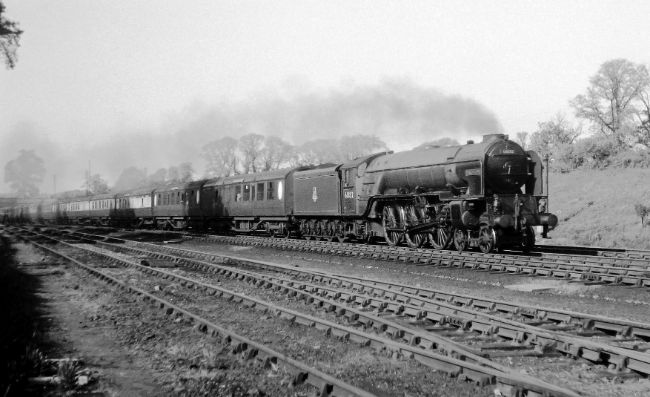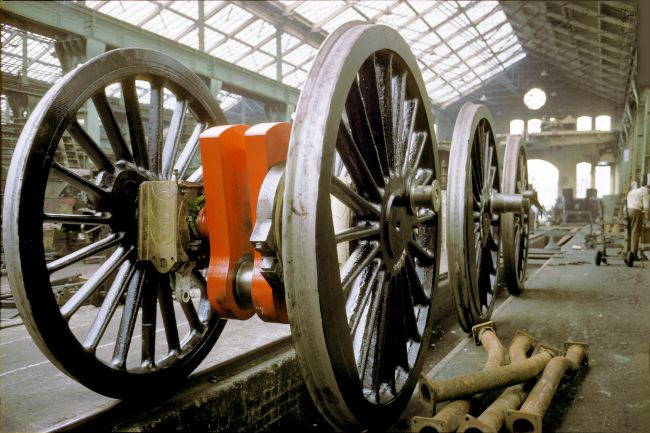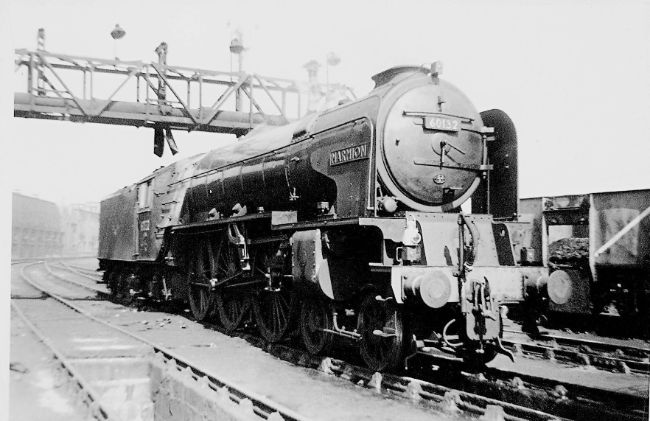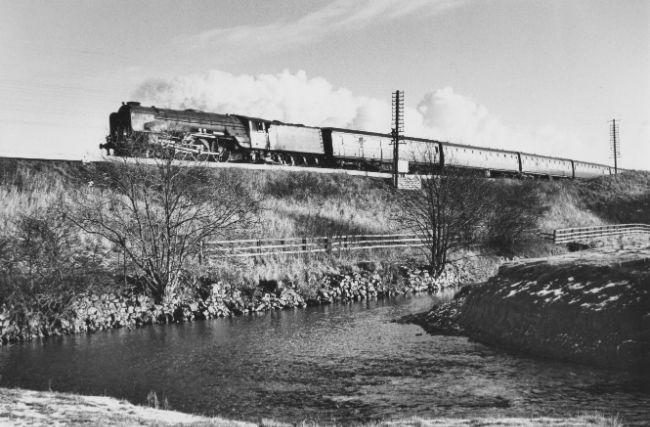No. 60132 was one of the early A1s, part of the initial Darlington Works build comprising Nos. 60130 – 60152, the order for which was issued in January 1947. Works No. 2051 was noted there on 10th September 1948 fitted with boiler No. 3913. It was one of five to be completed in October (two at Doncaster and three at Darlington) and was preceded by two Doncaster and two Darlington examples. It joined No. 60115 at Gateshead shed and entered traffic on 18th October and with more A1s delivered over the next year it was one of a total of thirteen A1s shedded there at that time. Gateshead A1s were noted for their long spells there, No. 60132’s allocation of 11 years and 7 months was slightly above the average for those thirteen. First sightings were on the 23rd at Darlington, there again on the 30th with an up passenger train then the 20:10hrs Leeds-Darlington train on 3rd November. The locomotive was in the early BR livery of apple green with white and black lining and the owner’s name spelt out in white capital letters on the tender. Along with fifteen other Darlington-built A1s the numbers and letters were in old gold. The new engine travelled along the East Coast Main Line (ECML) between the two capitals. On 20th and 30th December No. 60132 hauled the 13:15hrs from King’s Cross while on 2nd April 1949 it was on Haymarket shed. Its first named train was the Up ‘Flying Scotsman’ from Newcastle on 8th June 1949. A failure was a diverted Edinburgh-King’s Cross train on 11th September when No. 60132 failed at Stockton. A V2 was substituted on the fifteen coach train while B1 No. 61220 took No. 60132 to Stockton shed. Eleven days later No. 60132 entered Doncaster Works for general repairs. It was from there that it reappeared in BR blue with black and white lining in early November. It was one of two such A1 repaints that month, joining another repainted earlier plus the thirteen which had carried that livery from new.
Though No. 60132 was one of the early class members, over half of them (28) had been named when it became Marmion in December 1950 (when three others were also named). This is one of a number of A1s to have names from Sir Walter Scott’s writings. It comes from an epic poem published in 1808 about the Battle of Flodden Field in 1513 when English forces decisively defeated the Scottish army. It follows the exploits of Lord Marmion, a favourite of Henry VIII, on and off the battlefield. Marmion was killed in the battle. A general overhaul, with the fitting of boiler No. 29865, including a repaint into BR green with orange and black lining with the early emblem came in March 1952, again about halfway through the class being so repainted. A variety of work was done by No. 60132, it ranged from the 17:19hrs Leith Walk/Niddrie-Marylebone goods as far as Newcastle on 21st August 1950, a down special from King’s Cross seen at Stockton at 16:00hrs on 14th October 1951 to a parcels from King’s Cross on 13th March 1952. Two runs with the Up ‘Flying Scotsman’ were noted in summer 1951, the first seen at Grantham but the second on 6th June was when Marmion failed at Doncaster and B17 No. 61635 took over. A further ‘General’ in July 1953 saw the locomotive equipped with boiler No. 29814. As well as travels along the ECML No. 60132 reached Carlisle on 2nd August 1953.

No. 60132 Marmion on an up express near St Neots, 2nd June 1951 – Peter Townend
Between 1953 and 1959 Marmion was recorded on a lot of named trains, particularly in 1957. The ‘Flying Scotsman’, ‘Night Scotsman’ and ‘North Briton’ featured a lot plus ‘The Heart of Midlothian’, ‘The Aberdonian’, ‘The Tees-Tyne Pullman’ then later ‘The Talisman’ and ‘The West Riding’. Some of these were Up workings into Newcastle or down from there. After a general overhaul in April 1955 (boiler No. 29812) work included the up ‘Flying Scotsman’, worked as far as Grantham on 23rd December 1955, returning on the 17:40hrs ex-King’s Cross up to Newcastle. On 25th, 27th and 30th September 1957 it worked the ‘Night Scotsman’ into King’s Cross. It was often the practice for King’s Cross shed to use Gateshead A1s on a return trip to Peterborough or Grantham. The diagram for Marmion for 3rd January 1957 illustrates this. It arrived at King’s Cross at 06:20hrs on a train from Edinburgh, left at 10:45hrs on a passenger to Grantham, returned with the up ‘Flying Scotsman’ then departed for Newcastle at 22:15hrs with ‘The Night Scotsman’.
Along with this prestige work was the normal variety for the class of passenger, parcels and goods, but notable were a couple of arrivals at King’s Cross with the sleeper train. Some of No. 60132’s workings were via the Durham coast line like the 16:15hrs from Newcastle bound for Liverpool. Not prestigious but still important traffic was the up fish train seen passing through Newcastle on 21st January 1957. After hauling a down goods into Newcastle on 27th April Marmion was later seen pulling just a brake van past Usworth where the combination was also seen on 17th May. The engine was on its travels when it hauled a King’s Cross–Glasgow through a diversion via Bishop Auckland on 19th May 1957 and when on 29th June it took the 07:40hrs Sunderland–Bristol as far as Sheffield, returning on the 08:30hrs ex-Cardiff back to Newcastle. A further overhaul in April 1958 saw the locomotive equipped with boiler No. 29834 and during this period, in August 1958, the later BR crest was placed on the tender, being one of the last to be so fitted.
After attention at Doncaster in November 1959 (boiler No. 29836 fitted), a change of shed came in May 1960 when No. 60132 was one of a quartet of A1s transferred across the Tyne to Heaton along to join three already there and another five which came later to give a dozen for a while. Heaton A1s usually worked to Edinburgh, York and Leeds so its sphere of operation remained largely the same but with a few workings beyond. Examples include an additional train from Newcastle on 28th May at 12:10hrs for King’s Cross, an extra Edinburgh-King’s Cross train into Newcastle at 16:10hrs on 13th August and the Up ‘Northumbrian’ from Newcastle as far as Peterborough on 3rd April 1961. It was seen at Haymarket and York sheds but also Carlisle Citadel station and Copley Hill shed. Its final general overhaul took place during September 1961 when it acquired its last boiler, No. 29811, and was followed by a journey outside its normal area on 7th November 1961 when it hauled the 16:03hrs Edinburgh–Perth. Marmion took the 2S52 13:28hrs from Carlisle to Edinburgh on the 21st and 24th of April 1962. It was seen at Stockton on 29th June with an extra through South Shields–King’s Cross train. Named trains were still pulled like the Down ‘Heart of Midlothian’ from Newcastle on 25th May, the Up ‘Norseman’ on 16th June from Newcastle then the Edinburgh–Newcastle leg of the Up ‘Queen of Scots’ on 25th July. Its travels took it further again when on the 28th it left Newcastle with the 1F56 10:46hrs train for Glasgow and was seen in Fife next day on Thornton Junction shed.

Marmion’s driving wheels at Doncaster during its final overhaul there – Cedric Clayson
On 9th September 1962 Marmion and ten other A1s were transferred to Tweedmouth. It worked a number of trains south to Tyneside and beyond like the afternoon Heaton–Thornaby goods on 11th September, the 2G85 Berwick–Newcastle four days later and the up seed potatoes on 4th and 20th December. Northbound workings included the 1S31 York–Edinburgh train as far as Newcastle followed by the 2G85 Newcastle–Berwick stopping train on 28th November and the afternoon York–Newcastle parcels on 7th December. Workings in Scotland were usually as far north as Edinburgh such as the 1N21 18:30hrs Edinburgh–Newcastle train on 19th July 1963 but earlier, on 14th April No. 60132 had reached Perth shed. Rather more prestigious work was hauling the down ‘Anglo-Scottish Car Carrier’ from Newcastle on 22nd August. Its travels included a sighting each at Copley Hill and Carlisle Kingmoor sheds. Mundane but essential was the ballast train it hauled tender first at Tyne Yard on the morning of 28th December, more unusual was the 6S50 16:20hrs Carlisle–Portobello train on 4th May 1964. June showed several typical A1 runs of that time with Berwick–Newcastle and return trains. Other main line trains were still worked like the 10:10hrs Edinburgh–King’s Cross passenger train brought into Newcastle on 13th June and the 3S46 York–Edinburgh parcels brought into Newcastle on 23rd July.

In final condition, No. 60132 is seen at ‘Top Shed’ on 17th June 1962 – David Hamilton

Marmion is captured at Brafferton in December 1963. – Chris Nettleton
A final move back to Gateshead shed was made on 6th December 1964 along with four other A1s to join the trio already there. A mix of passenger and goods work was done in No. 60132’s final months in traffic. Two days later it was on an up Class 8 at Newcastle around midday and a Down Class 4 express goods from Newcastle on 17th February 1965. A passenger working was the 1N84 ex 13:40hrs from Bristol into its Newcastle destination on 22nd January. Later it had been to Edinburgh as it was seen on St. Margarets shed on 27th February. On March 11th it was taken from Gateshead shed to Tyne Dock shed for storage but was returned to Gateshead on 2nd May. Its final recorded working was on 7th May when it hauled the 2G85 Berwick-Newcastle and return. Marmion was withdrawn on 14th June and was noted at Tyne Dock shed yard on the 26th. It was one eight A1s withdrawn that month. In July it was one of four sold to breakers Hughes, Bolckow of Blyth, Northumberland. It was last seen there on 21st August.
Although No. 60132 was one of the early class members, over half the class had already been withdrawn when it finally came out of traffic. It was in service for 16 years and eight months, about a year and a half longer than the class average. During its time it had been fitted with eight boilers, all of them diagram 118 designs.
This history was compiled by Phil Champion based on a database compiled by Tommy Knox and with reference to the RCTS book “Locomotives of the LNER Part 2A” as background. Revised and updated by Graham Langer – June 2020.